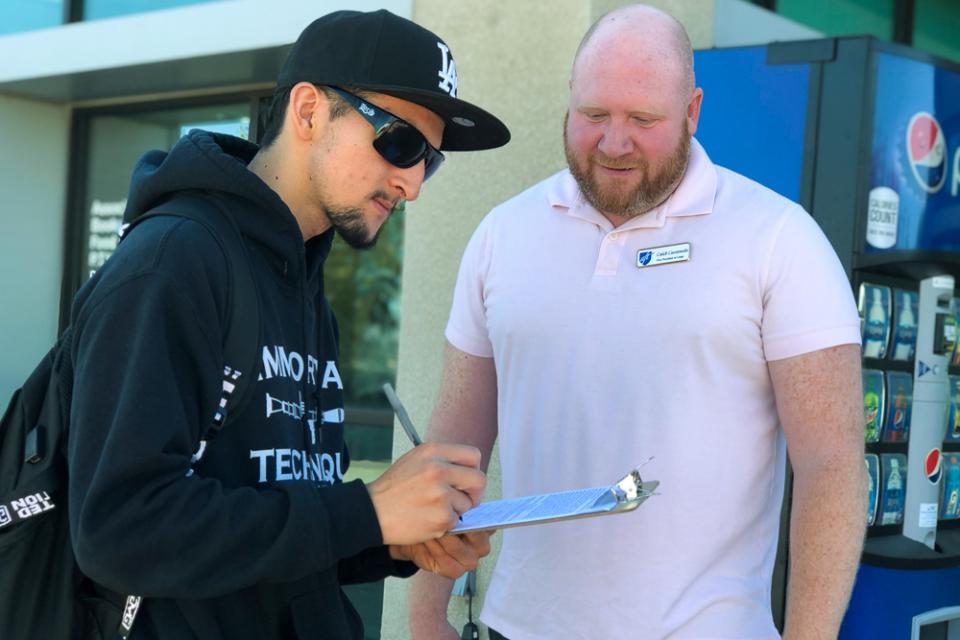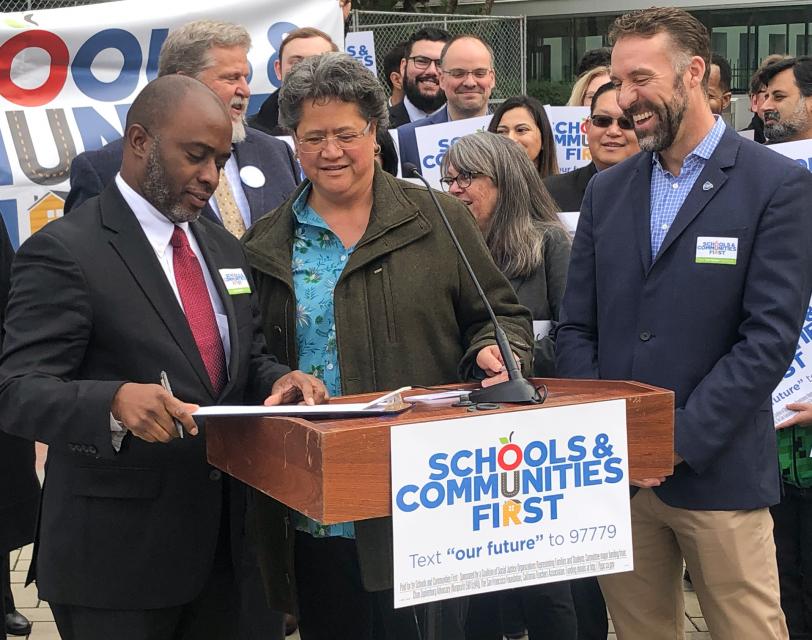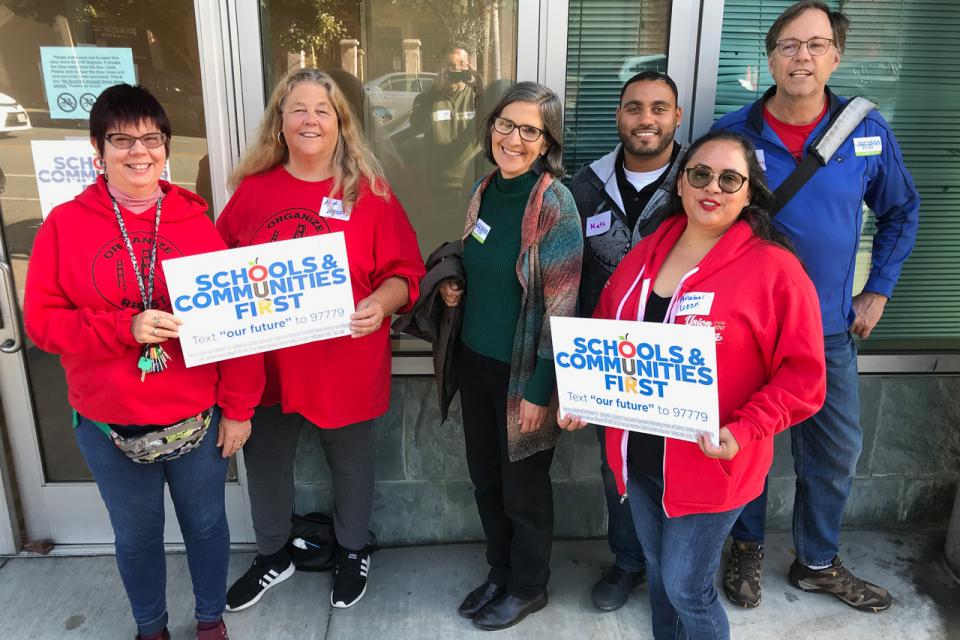Update: On June 4, Schools and Communities First officially qualified for the November 3 General Election ballot.
Last fall, when CFT began circulating petitions to qualify the Schools and Communities First initiative, seems like a world away. Yet on April 1, the early days of the coronavirus outbreak, the coalition submitted 1.7 million signatures, nearly twice the number needed to put the measure on the November ballot and the most ever gathered in California history.
CFT members and their allies worked tirelessly during fall semester and over the holidays to spread the word about Schools and Communities First and close in on CFT’s ambitious goal of collecting 20,000 signatures.
Heading into March, many local unions saw the Primary Election as an opportunity to lay groundwork for the General Election and coupled “Get Out the Vote” events with petition signing.
With the March 20 submission deadline fast approaching, stay-at-home orders swept the state and schools began to close. Events were canceled and, at the direction of public health agencies, educators and staff hunkered down at home. But CFT members had hit the ground early and, by full lockdown, the union reached its 20,000 goal.
“Gathering signatures tapped into all aspects of being a teacher,” said Hilary Mitchell, third grade teacher at Washington Elementary and member of the Berkeley Federation of Teachers. “It required diligence and consistency, and allowed me to connect with families at school to fight for a common cause.”
Schools and Communities First represents a paradigm shift. When it passes, this measure will reform decades-old tax law that allows corporations to avoid paying property taxes at fair market value. This unfair tax system has resulted in homeowners and small businesses shouldering a disproportionate share of the tax burden while wealthy corporations like Chevron and Disneyland are allowed to engage in shady tax avoidance schemes and pay very little.
As a result, public education and community services lose $7 to $12 billion each year from uncollected corporate property taxes. The lost funding year after year means that educators constantly have to do more with less. Passing Schools and Communities First will correct this inequity, while protecting homeowners and renters, small businesses, and agricultural property.
Now with the state facing an unprecedented economic collapse, these extra resources will be essential to ensure our schools and colleges are not rocked — once again — by layoffs and program cuts. California was once among the top ten states for per pupil funding, but since the 1970s the state has plummeted to the bottom ten.
“School funding here is already so low,” said Monica Casey, president of the Jefferson AFT Federation of Teachers. “In our district it’s even lower than most surrounding districts, and some members have second — or even third — jobs. Plus this current mode of ‘at home learning’ is showing just how hard it is to educate young people.”
AFT Local 1481 represents certificated and classified staff in Daly City high schools. Casey said everyone does incredible work by making do with scarce resources, “but they deserve much better.”
Erinn VanderMeer, a visual arts and photography teacher at Kenilworth Junior High School agrees. “As a student of the 70s and early 80s myself, it’s been obvious to me just how much was lost with the corresponding drop in funding.”
The Petaluma Federation of Teachers member said, “Ever since I started teaching, I’ve been hoping to be a part of a solution, something that will provide long-term and substantial funding for our schools.”
VanderMeer is not alone. Many educators have been waiting years, if not decades, for the opportunity to make changes to the corporate tax policy that Schools and Communities First will bring about.
Putting that desire into action, CFT and a coalition of labor and community groups banded together to address the gross inequity that exists in California’s property tax code, and leaves public education and treasured community resources like public parks, libraries, public health clinics, and emergency services drastically underfunded.
The CFT collaborated with many of the same groups to pass recent revenue measures — Proposition 30 in 2012, and its extension, Proposition 55 in 2016. With this shared vision, the coalition crafted a plan to qualify Schools and Communities First for the November 2020 ballot.
First up was collecting 1.5 million signatures. The CFT committed to 20,000, more than any prior commitment, and knowing the March 20 deadline was difficult given final exams, winter break, and the early March 3 primary.
Next local unions set signature-gathering goals and planned events. They joined with parent and campus groups to spread the message about how the new measure will restore funding for public education. Members asked their colleagues, friends, and family members to sign petitions.
“We thought getting involved was important,” said Patti Serafin, a financial aid advisor at Palomar College who led the charge in her union’s campus education outreach.
Serafin, a member of the Palomar College Council of Classified Employees, says schools are the heart of many communities and students and families are the state’s most valuable resource.
Students joined the signature-gathering effort too. “Our AFT student intern team was passionate about this,” says Jim Miller, an English professor at San Diego City College, “because they understand how that extra revenue can be a game changer.”
Miller is also political director for the AFT Guild, Local 1931. “As a social justice union, we see the effort to close this corporate tax loophole as part of the larger battle against the deep economic inequities that harm our students and the communities we serve.”
Working together, San Diego faculty, staff, and students collected 2,000 signatures. Similarly, AFT Local 2121, the faculty union at City College of San Francisco, gathered more than 2,000 signatures. These two extraordinary efforts accounted for 20 percent of CFT’s statewide goal.
Though the landscape is uncertain in coming months, we know without a doubt the pandemic has caused the largest fiscal hole in California history. CFT members can be proud of the work they did to qualify this historic initiative for the ballot, and come November can look forward to casting a vote for public education that’s never been more important.
— By Jessica Ulstad, CFT Political Director



